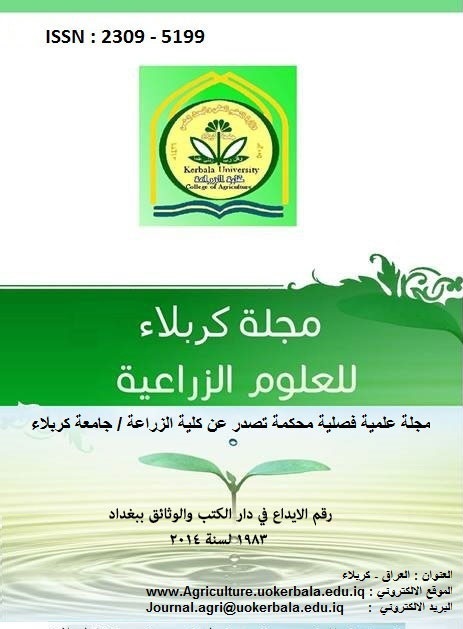The evaluation of fungus effectiveness of Tricherma harzianum and penicillium oxalicum in the control of pythim aphanidermatum fungus the causative of cucumber seeds rotting
Kadhom Hussain Kadhom Albehadi
DOI:
https://doi.org/10.59658/jkas.v4i1.86Keywords:
root rot of cucumber, Pythium aphanidermatum Trichderma harzianum and Penicillium oxalicumAbstract
The study's included isolation six isolates of the Pythium aphanidermatum and knowledge of its ability to root rot of cucumber, if that possiblityto control by using two fungi Trichderma harzianum and Penicillium oxalicum.
The results showed that all isolates fungus P.aphanidermatum was a pathogenesis at the plant cucumber was the most virulent is the isolation (P3) where the percentage of germination of the seeds of the existence of this fungus is 13.3 % compared with 80% in the control , As well as this isolation has made reductions revealed a significant differences on the rate of fresh and dry weight of plant cucumbers where they were 0.043 and 0.0113 g, respectively, compared with 0.268 and 0.692 g, respectively, in the treatment comparison, and have achieved as well as less weight Fresh and dry root plant where it was 0.0053 and 0.0008 g, respectively, compared with (0.0328 and 0.0054) g, respectively, for the treatment of comparison. The results showed that the fungi biological control T. harzianum and P. oxalicum antagonistic ability against all isolates fungus P.aphanidermatum and the degree of antagonistic with isolation (P3) 2 for each of the fungi biological control T. harzianum and P. oxalicum. The results also showed an ability of biology control fungi T. harzianum and P. oxalicum seeds to protect and increase the percentage of germination, they were 72 and 68 %, respectively, with the presence of pathogenic fungus P.aphanidermatum while 16% in the treatment, which only add the fungi pathogen P.aphanidermatum, also achieved these two fungi T. harzianum and P. oxalicum significant difference in the growth of seedlings cucambers where they were fresh and dry weight of the total vegetative with T. harzianum and the presence of the pathogen is a fungus 0.166 and 0.019 g, respectively, and with the fungi P. oxalicum and the presence of pathogenic fungus is 0.153 and 0.014 g, respectively, compared with 0.23 and 0.006 g in the treatment , which only add the pathogen fungus was fresh and dry weight of the root with T. harzianum and the presence of pathogenic fungus is (0.163 and 0.00113) g However respectively fungus P. oxalicum and the presence of the pathogen is a fungus 0.154 and 0.00106 g, respectively, compared with 0.0065 and 0.00023 g on the treatment , which only add a pathogenic fungus
Key words : root rot of cucumber, Pythium aphanidermatum Trichderma harzianum and Penicillium oxalicum
Downloads
Published
How to Cite
Issue
Section
License
Copyright (c) 2018 Copyright (c) 2024 is the Author's article. Published by the Journal of Kerbala for Agricultural Sciences under a CC BY 4.0 license

This work is licensed under a Creative Commons Attribution 4.0 International License.
Licensing Terms
All articles are published under a Creative Commons License and will be directed to the Creative Commons Attribution 4.0 International License (CC BY 4.0) That permits use, distribution, and reproduction in any medium, provided the original work is properly cited. This license also allows the work to be used for commercial purposes.
Use by both non-commercial and commercial users
This content is licensed under a Creative Commons Attribution 4.0 International (CC BY 4.0) license, permitting use by both non-commercial and commercial users. Individual users may access, download, copy, display, and redistribute the articles to colleagues, as well as adapt, translate, and text- and data-mine the content, subject to the following conditions:
- The author's moral rights, including the right of attribution and the right to protect their work from derogatory treatment, are respected.
- Where content in the article is identified as belonging to a third party, users must ensure that any reuse complies with the copyright policies of the owner of that content.
- If the article content is reused for research or educational purposes, users should maintain a link to the appropriate bibliographic citation, including the DOI and a link to the published version on the journal's website.

